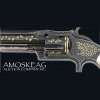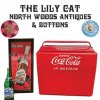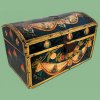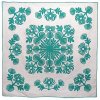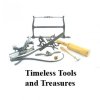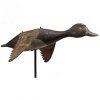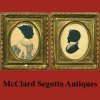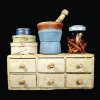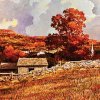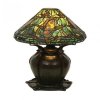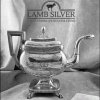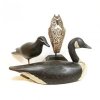March Auction Features Variety and Value
May 27th, 2016
Laughlin Auctions, Inc., Edinburg, Virginia
Photos courtesy Laughlin Auctions, Inc.
Laughlin Auctions, Inc. was founded in 1986 by three brothers, Hoyle, John, and Duane Laughlin, and its first sale was held over that year’s Memorial Day weekend. Each year since, the firm has held an annual spring auction, and this year’s, the 29th, was held March 19.

This brightly painted hanging shelf unit, approximately 20" high, appears to be constructed of pine and retains a paper label on the back that reads “Manufactured By / John W. Nail / Winchester, Va. / All kinds of frames made to order.” The red-washed surface is decorated with leaves, fans, and S-curve geometric patterns. John Nail was born in 1880, and his handiwork is prized by collectors of Shenandoah Valley objects. The shelf brought $2300.
The Laughlins operate from their galleries in Edinburg, Virginia. I say “galleries” because their 15,000-square-foot facility is divided into three large salesrooms, and the large lobby area is often used as a fourth. The March 19 sale utilized every square foot of the building, with four auctioneers—the brothers are assisted by the firm’s longtime member Richard “Richie” Minton—simultaneously selling throughout the building.
 There is a bit of controlled chaos in the undertaking. Depending on where one is seated or standing, two and sometimes three PA systems compete for your attention. In addition to the potential acoustic overload, the Laughlin auctions do not have a formal catalog. Individual single-page handouts are available that list the sequence of the sale within specific categories, such as pottery or coins or silver, and certain large items, such as automobiles, are sold at predetermined times. The remaining items in the sale are sold in an orderly manner, with the auctioneer moving from table to table and from wall to wall. Auction patrons are left to their own devices as how to coordinate their timing and movement if they are interested in items being offered in several of the galleries.
There is a bit of controlled chaos in the undertaking. Depending on where one is seated or standing, two and sometimes three PA systems compete for your attention. In addition to the potential acoustic overload, the Laughlin auctions do not have a formal catalog. Individual single-page handouts are available that list the sequence of the sale within specific categories, such as pottery or coins or silver, and certain large items, such as automobiles, are sold at predetermined times. The remaining items in the sale are sold in an orderly manner, with the auctioneer moving from table to table and from wall to wall. Auction patrons are left to their own devices as how to coordinate their timing and movement if they are interested in items being offered in several of the galleries.

This mid-19th-century Virginia yellow pine corner cupboard, 82" x 39" x 22", was the highlight of the furniture offerings at $3400. Presented in as-found condition with three missing panes and one broken pane of glass, it features peg and hand-wrought nail fasteners. The single upper door encloses three shelves, the uppermost one with spoon slots; the single door below has two fielded panels; and the tall four-piece cornice has a modified ogee form highlighted by a band of spaced and reeded dentil-like ornament. The bracket feet appear to be original (one is missing a portion of its decorative spur cutout), the iron latches are later additions, and there is evidence of white and green paint.
My previous visits to Laughlin’s have been triggered by specific items on offer. In 2011 there was a painted miniature blanket chest attributed to the Stirewalt group of Shenandoah Valley painted furniture; in 2012 there was a blanket chest decorated by Johannes Spitler; and in 2013 a rare Page County, Virginia, one-piece inlaid walnut corner cupboard crossed the block. There was no single blockbuster lot at this sale, but it was a good old-fashioned country auction with as wide a variety of merchandise as anyone can imagine. It was the sort of sale where dealers buy for stock, collectors look for an unpolished gem to add to their collections, and local auction hounds come to mingle and swap stories.

This bright yellow pressed-steel pedal car by Murray measures 46" long x 15" high x 16" wide and is marked “Heavy-Duty Dump Truck, No. 742” and “Sand and Gravel.” It appears to be complete and in working order, though there is significant scratching and wear from use. It dates from the 1950s and brought $130.
The highest-priced lot of the day came from among the furniture lots: an early 19th-century corner cupboard in yellow pine that had literally been hauled out of a shed and onto the auction floor. At some point it had been painted—or at least it had painted trim—but the cupboard was offered in a dry scrubbed surface with faint traces of green and white paint in the reeded dentil work. It sold to a Shenandoah Valley dealer for $3400 (Laughlin’s does not charge a buyer’s premium).

This 11" high one-gallon stoneware pitcher by WH Lehew & Co., Strasburg, Virginia, sold for $850. It has a distinctive 4" high collar, and the body and spout area are decorated with brushed cobalt designs.

This 6¼" tall signed redware crock with a brown/orange glaze that transitions to green at the base led the pottery lots. It features a wide squared rim, below which is incised “Isaac Good” within an elongated dotted outline cartouche, below which are three incised rings. Isaac Good was a longtime potter at Emanuel Suter’s New Erection Pottery in Rockingham County, Virginia, during the fourth quarter of the 19th century. Signed examples of Good’s work are scarce, so this little pot brought $1600.
A second noteworthy lot was a painted hanging shelf unit with a paper label for John W. Nail, a frame maker in Winchester, Virginia. His pieces do not turn up with any frequency, and this shelf hit all of the magic words: Shenandoah Valley, painted woodwork, folk art, and rare. A collector purchased it for $2300.
One general bright spot that must be noted was the number of 20- and 30-somethings who actively participated in the auction process and bought in all categories. In fact, I sat beside an extremely disciplined young woman who was buying stoneware and won six lots. She had made notes beside each piece on the pottery list provided by the auction house and had her maximum bid circled beside each item. She did not exceed any of her limits. I asked whether she was a dealer, and she replied “no.” She explained that she and her husband have an interest in Shenandoah Valley pottery and are beginning a collection of local crocks.

Here is a nice 8¾" high unmarked tankard-form pitcher with a mottled green and brown multicolor glazed surface. Exhibiting a flared collar and incised rings at the shoulder, it brought $600.
One less than encouraging observation must also be noted. Furniture is still lagging badly. Only a handful of lots did not sell at this auction, and all were rather nice pieces of unpainted wooden furniture. Among the passed lots were a couple of one- and two-drawer stands and a tambour-style desk in cherry. All failed to receive any bids, despite Hoyle Laughlin’s coaxing at the $50 and $25 levels.
If one is interested in variety and value, check out the next sale at Laughlin’s, but remember, there is no online bidding. Show up in person and enjoy the day, or leave a bid as an absentee.
For additional information, call (540) 984-8080, or visit (www.laughlinauctions.com).

This 11" x 24" x 20" handmade pine and poplar storage box is divided lengthwise into two compartments. The top and sides are decorated with various hand-painted designs, including a central six-petal compass-drawn flower, and the remaining artwork appears to be freehand. The hand-wrought strap hinges appear to be original to the box, which sold for $450.

The largest piece of furniture at the sale was this 92" high x 47" wide one-piece 16-pane walnut corner cupboard with a broken-arch top. There are four shelves in the upper section and two shelves behind the fielded-panel doors below, and the outward edges of the stiles are reeded for their entire length. It brought $600.
Originally published in the June 2016 issue of Maine Antique Digest. © 2016 Maine Antique Digest

